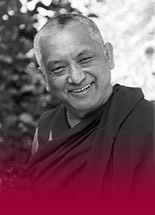Robina’s Blog
18 November, 2021
I don’t think we like the idea of patience. We think it’s like gritting our teeth and waiting for the awful thing to go away. For us it’s more like passive aggression!
So, what is it actually? T0 begin to understand it we need to be familiar with its opposite: anger. And to understand anger we need to understand its source, which is attachment. Of course, this is the Buddhist psychological understanding.
Attachment drives us. It’s primordial. It’s the assumption that I must get only the nice things, and that, of course, means that I must get only what I want. It’s so clear!
The moment what attachment doesn’t want happens – the red light, the loud noise, the person being mean to us, the child not doing what I want – aversion arises. It’s like a panic attack. And the stronger the attachment the more intense the aversion. If it’s very strong it arises as volatile anger; if it’s milder, it’ll be annoyance, irritation, frustration.
Everyone uses those words. They sound so normal. But they’re mild versions of anger. Look at our ordinary daily life: a thousand times a day we’re going to meet something that attachment doesn’t want – and we’re not talking big major things yet. We’re always getting irritated, getting annoyed, “Oh this wretched thing, why is it like this, it shouldn’t be this way, who does he think he is?” We don’t think of it as anger, but of course it is. And these moments build up, that’s the thing. WE don’t deal with them. And then at some point some small thing becomes the straw that breaks the camel’s back.
So, what’s patience? Patience is not just gritting your teeth, waiting for that mean thing to go away. Patience actually is a really brave, courageous attitude that welcomes that thing; that doesn’t just put up with it, “Oh, all right then!” passively, which is how we think about patience. “Be patient, come on!” Put up with something. No, no, no. It’s an active, active state of mind that says, “Great! Great!” You welcome the red light, the bad sound, the mean person.
Welcoming the opposite, welcoming the carrot cake when you ordered chocolate cake, not just putting up with it, and cursing under your breath, actually actively greeting it, welcoming it, being happy it’s there. This is amazing, as Lama Zopa says: it’s like we need to learn to like problems, like we like ice cream. Not just putting up with it, actively welcoming it. I mean, it sounds a bit crazy but it’s a very profound and it’s the quickest way to change your mind. It’s the quickest way to really be happy.
If we can be brave enough, try it – once a day even! Not just put up with it, welcome it. Because the fact is, remember, aversion, irritation, annoyance, upset, all these things, anger, are all responses to thwarted attachment. If attachment, as Buddha is saying, is the real source of our suffering, then we should be so happy when we get an opportunity to purify it. And you purify it when you don’t get what attachment wants. It’s very simple. It’s so simple.
Patience is not passivity. That’s simply putting up with something. Passivity is terrible. Patience is active, conscious. There’s a saying – from Buddha, from one of the holy beings, I don’t remember – “If you can change something, please change it! But what if you can’t?” That’s when patience comes in. Greeting the problem means you can analyze it, see it clearly, and then know how to act.
It's a profound practice. And not easy because it’s not our habit. We either scream and yell or passively put up with things. Both are so mentally unhealthy.
Anger is the view that the thing shouldn’t be happening, how dare it happen. The fact is, it is happening. Patience is an intelligent clear-eyed ability to see that, and then to find the solution.
Or the really brave attitude of actually greeting the problem – the criticism, let’s say – and then accepting it and letting it pass. This is amazing! Brave for sure.
The fact is, we can’t stop problems until we’ve given up attachment. It’s only then that we won’t have aversion, which is what interprets the thing as a problem.
So, one step at a time!

